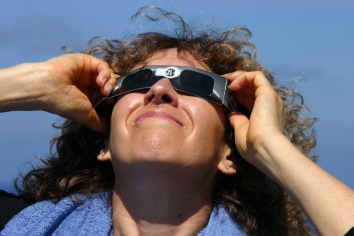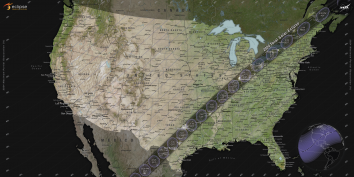
No matter where you experience the eclipse, it is vital to follow safe viewing practices and use eclipse glasses. Check to ensure yours are certified ISO 12312-2 and free of scuffs, holes, or other flaws. Image credit: Evan Zucker.
25 March 2024
On Monday, April 8, parts of North America will experience a total solar eclipse. This happens when the Moon passes between the Earth and Sun, completely covering the Sun’s disk. The brief moment when the Sun is 100% covered is called “totality.” To see it, you must be within the “path of totality,” a narrow band about 100 miles wide.
The path of totality for April’s eclipse travels from Mazatlán, Mexico, to the island of Newfoundland, Canada. It will sweep into the Lone Star State at Eagle Pass and exit near Texarkana.
McDonald Observatory and surrounding communities are outside the path of totality, so will only see a partial eclipse. “We’ll have a pretty deep eclipse, about 90%.” explains Rachel Fuechsl, programs manager at McDonald Observatory. “But that last 10% makes a huge difference.”
Those lucky enough to experience totality are in for a treat. They will watch the sky darken, feel temperatures drop, and see stars and planets become visible in the midday sky. During totality, the Sun’s outer atmosphere, its corona, will be visible and look like delicate, feathery tendrils radiating outwards. “When I saw the eclipse in 2017, it was the shortest three minutes of my life,” Fuechsl says. “It’s such a wondrously weird feeling.”
Texas cities within the path of totality include Eagle Pass, Del Rio, western San Antonio, Austin, Waco, and Dallas-Fort Worth. The closer you are to the center line, the longer totality will last – almost four and a half minutes at its maximum. “Anywhere along that path will get an amazing view,” says Lara Eakins, senior program coordinator for The University of Texas at Austin’s Department of Astronomy. “You don’t want to be at 99.9%.”
For those who have the option, McDonald Observatory recommends traveling to experience the event. However, if you haven’t made your plans yet, keep in mind that many eclipse tourists will be making this same trip. That can mean heavy traffic, high prices, and booked hotels. “You have to take into account that you and everyone else is trying to get to these good spots,” explains Eakins.
Those staying in the West Texas area are invited to celebrate the eclipse at McDonald Observatory. There, the partial eclipse will start at 12:09 p.m., peak at 1:27 p.m., and end at 2:47 p.m. At its maximum, the Moon will cover 90.9% of the Sun.
The Observatory will have telescopes set up for solar viewing, educational activities and demos, and a livestream of the eclipse from within the path of totality. General Admission includes an eclipse viewer and access to all eclipse activities. Residents of Jeff Davis, Brewster, and Presidio counties receive free General Admission with valid proof of residency.
No matter where you experience the eclipse, it is vital to follow safe viewing practices. Outside the path of totality, you must use adequate eye protection at all times. This can include eclipse viewers or glasses. Check to ensure yours are certified ISO 12312-2 and free of scuffs, holes, or other flaws. If you still have some from October’s annular eclipse, and they are in good condition, you can reuse those.
Inside the path of totality, it is safe to look at the eclipse with your naked eye when the Sun is completely covered by the Moon. “But that’s it!” warns Eakins. At all other times, it is unsafe to look at the eclipse without protection.
To help ensure communities are prepared to safely experience this event, McDonald Observatory has distributed educational handouts and over 100,000 eclipse viewers through community partners. It has also held training sessions for anyone interested in hosting their own viewing event. A recording of this training is available at mcdonaldobservatory.org/eclipse.
Whether yours will be a partial or a total eclipse, it is sure to be a memorable sight. To get the most out of it, visit mcdonaldobservatory.org/eclipse for more information, resources, and helpful links. For additional safety tips, visit eclipse.aas.org.

No matter where you experience the eclipse, it is vital to follow safe viewing practices and use eclipse glasses. Check to ensure yours are certified ISO 12312-2 and free of scuffs, holes, or other flaws. Image credit: Evan Zucker.

Path of totality in the U.S. Outside of the path of totality, a partial solar eclipse will be visible in all of contiguous U.S. Image credit: NASA.

During totality, when the Moon completely covers the Sun, the Sun’s corona (its outer atmosphere) becomes visible. It will look like delicate, feathery tendrils radiating outwards. Observers must be within the path of totality to see this phenomenon. Image credit: Damien Deltenre, Penn State.